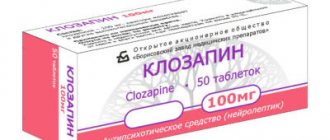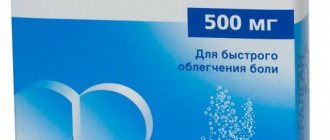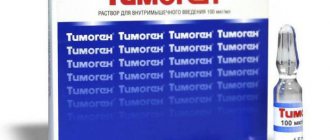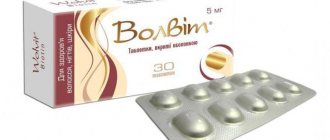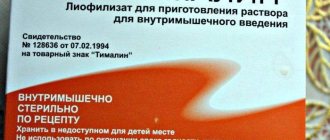Write a review
Reviews: 0
Manufacturers: Teva (Pharmaceutical company)
Active ingredients
- Meloxicam
Disease class
- Rheumatoid arthritis, unspecified
- Polyarthritis, unspecified
- Arthritis, unspecified
- Arthrosis, unspecified
- Joint pain
- Ankylosing spondylitis
- Radiculopathy
- Dorsalgia, unspecified
Clinical and pharmacological group
- Not indicated. See instructions
Pharmacological action
- Anti-inflammatory
- Antipyretic
Pharmacological group
- NSAIDs - Oxycams
The drug: its composition and form of production
The drug belongs to enolic acid derivatives. Helps fight fever, perfectly relieves pain and has an anti-inflammatory effect. The drug inhibits the activity of cyclooxygenase, which leads to suppression of the production of prostaglandins, which act as mediators of inflammatory processes.
The main component is meloxicam. Meloxicam-Teva tablets also contain additional components:
- Monocrystalline cellulose.
- Lactose monohydrate.
- Povidone.
- Sodium citrate dihydrate.
- Magnesium stearate.
- Colloidal silicon dioxide.
- Crospovidone.
The manufacturer produces Meloxicam-Teva in tablet form containing 7.5 or 15 ml of the active substance.
The drug is also available as an injection solution in 1.5 ml ampoules. The content of the main active ingredient is 15 mg.
The Meloxicam solution has the following composition, if we consider additional components:
- Meglumin.
- Poloxamer.
- Glycine.
- Sodium chloride.
- Sodium hydroxide.
- Tetrahydrofurfuryl macragol.
The injection solution is yellow and slightly greenish.
Analogs
“Dikloberl”
Berlin-Chemie Ag, Germany Price from 300 to 350 rub.
A non-steroidal drug that has anti-inflammatory and analgesic effects. The substance that acts as the main component is diclofenac sodium. The medicine is presented in the form of tablets, injection solution and rectal suppositories.
pros
- Effectively relieves inflammation.
- Rapid action of the active substance
Minuses
- Take strictly as prescribed by your doctor
- Many adverse reactions.
"Movalis"
Boehringer Ingelheim International GmbH, Germany Price from 510 to 700 rub.
An anti-inflammatory medication that eliminates the symptoms of diseases of the joints and spine. Effectively relieves inflammation and eliminates pain. The active ingredient is meloxicam, produced in the form of tablets, capsules, suppositories and solution for injection.
pros
- Compared to other NSAIDs, it has a milder effect
- Well tolerated
- Has a minimum of unwanted reactions
Minuses
- Contraindicated for pregnant women and children
- High price.
Pharmacodynamics
After entering the gastrointestinal tract, the drug is almost completely absorbed, bioavailability is about 90%. The maximum content of the main substance in the blood plasma is detected 5-6 hours after a single use. The quality of absorption is not affected by food intake.
Meloxicam binds well to proteins, especially albumins, and penetrates into the synovial fluid. The main metabolism of the drug occurs in the liver. Excretion in urine and feces within 15-20 hours. Minor problems in the functioning of the liver and kidneys do not lead to the accumulation of the active substance in the body.
Cross-drug interactions
In combination with antihypertensive substances Meloxicam-Teva, their effectiveness decreases.
Concomitant use with anticoagulants increases the risk of bleeding. Concomitant use with diuretics may cause renal failure. When combined with other NSAIDs, there is a risk of developing gastric and intestinal bleeding.
Meloxicam-Teva, together with lithium preparations, increases the concentration of lithium in the blood plasma.
Cholestyramine speeds up the withdrawal of meloxicam.
What does Meloxicam-Teva help with?
The drug has proven its therapeutic effect in the treatment of many pathologies. The instructions for the medicine contain detailed information. Meloxicam-Teva has the following indications for use:
- Arthritis.
- Rheumatoid arthritis.
- Osteoarthritis in acute form.
- Chronic form of polyarthritis.
- Spondylitis.
- Osteoarthritis.
- To relieve pain from joint diseases, osteochondrosis and radiculitis.
Meloxicam-Teva injections are prescribed to relieve acute pain symptoms in rheumatoid arthritis or spondylitis, if the tablets do not bring the desired effect or it is not possible to take them orally.
Who is contraindicated for Meloxicam-Teva therapy?
There is a category of pathologies and conditions for which it is not recommended to prescribe this drug:
- Excessive sensitivity to the main active ingredient or any auxiliary component.
- Allergic reactions to acetylsalicylic acid and drugs of the parazolone group and a history of evidence of the development of allergic rhinitis, urticaria while taking any NSAID.
- Recovery stage after coronary bypass surgery.
- Bronchial asthma.
- Polyposis of the nasal cavity and sinuses.
- The presence of ulcerative pathologies of the stomach and intestines.
- There is a history of intestinal and gastric bleeding.
- Inflammatory processes in the small and large intestines, such as Crohn's disease or colitis.
- Hereditary diseases: lactose intolerance.
- Cerebrovascular bleeding.
- Heart failure.
- Severe renal pathologies.
- Pregnancy.
- Breast-feeding.
- Age up to 15 years.
If we consider the contraindications for Meloxicam-Teva injections, they are the same, but it is necessary to add:
- Blood clotting disorder.
- Hyperkalemia.
- Age up to 18 years.
All these contraindications must be taken into account; the instructions for Meloxicam-Teva contain this information.
Scheme and dosage of the drug in tablets
Considering that drug therapy in large dosages and long-term use is fraught with serious side effects, Meloxicam-Teva (the instructions for use confirm this) must be used in short courses and in the minimum effective dosage.
It is advisable to take the product once a day, before meals, with plenty of water. The recommended dosage is as follows for various pathologies:
- If a diagnosis of arthritis or spondylitis is made, the medicine is prescribed at a dose of 15 mg once a day. If a good therapeutic effect is observed, the dosage can be halved.
- For the treatment of osteoarthritis, take 7.5 mg per day; if necessary, the dose can be increased to 15 mg. It should be noted that for people over 15 years of age, the dose is calculated at 0.25 mg per kilogram of body weight.
- When treating elderly patients, the initial dose should not exceed 7.5 mg.
- If there are minor deviations in the functioning of the liver and kidneys, then there is no need to reduce the dosage.
During treatment with the drug, you must monitor your condition and tell your doctor if you notice any side effects.
Therapy with injection solution
Instructions for use recommend using Meloxicam-Teva injections in treatment as follows:
- The drug is injected deep into the muscle.
- Therapy is allowed during the first days, and then a transition to tablets is made.
- If osteoarthritis is diagnosed, 0.5 ampoules (7.5 mg) per day are initially prescribed. If the doctor deems it necessary, the dosage can be increased to 15 mg.
- To relieve acute arthritis or spondylitis, 1 ampoule is administered once a day. If a good effect is observed, the dosage is reduced by half.
- If there are minor deviations in the functioning of the excretory system and liver, the dosage per day is 7.5 mg.
Treatment is carried out under the supervision of a doctor.
Price
The drug is available only with a prescription.
| Release form | Amount in a package | Average price in Russia | Average price in Ukraine |
| Tablets 15 mg | 20 pcs | 270 rubles | 130-140 hryvnia |
| Tablets 7.5 mg | 20 pcs | 175 rubles | 80-90 hryvnia |
| Solution | 5 ampoules | 520 rubles | 180 hryvnia |
Taking the drug if you have problems with the kidneys and liver
If a patient has chronic renal failure and does not undergo dialysis, or has serious progressive kidney pathologies, then use is strictly prohibited. A clearance of 30-60 ml/min in case of renal failure allows taking the drug, but only under the constant supervision of doctors.
Minor deviations and a clearance of 30 ml/min allow you to take the medicine in the recommended dosage.
The presence of progressive liver diseases is a categorical ban on therapy with Meloxicam-Teva. Such therapy is prescribed under special supervision if liver cirrhosis is diagnosed.
Side effects during therapy
It should be noted that Meloxicam-Teva tablets, when taken, can provoke the following undesirable effects:
- Disorders in the digestive tract: nausea and vomiting, abdominal pain, and stool disorders are often observed. Some patients experienced the development of stomatitis, belching, and bleeding in the gastrointestinal tract. Hepatitis, colitis or gastritis were very rarely diagnosed.
- Taking Meloxicam-Teva (the instructions for use describe such cases) often provokes the development of anemia, sometimes tests show thrombocytopenia, leukopenia or agranulocytosis.
- Rashes, itching, and urticaria appear on the skin. Rarely, toxic epidermal necrolysis, erythema and photosensitivity develop.
- On the part of the respiratory system, bronchospasm is noted. If there is hypersensitivity to acetylsalicylic acid, an asthma attack may develop.
- The nervous system may respond to Meloxicam-Teva therapy (reviews confirm this) with headaches, dizziness, fatigue and drowsiness. Confusion and emotional instability rarely occur.
- If you have a tendency to hypertension, then taking the drug can cause increased blood pressure and heart rhythm disturbances. Some patients report swelling and hot flashes.
- Urinalysis shows changes in kidney function indicators; renal failure and nephritis rarely develop.
- The organs of vision may also be damaged: the clarity of vision is impaired, and conjunctivitis develops. The vestibular apparatus may be affected, then tinnitus and spatial orientation disturbance appear.
- Allergic reactions to the drug are very rarely observed.
- The liver suffers, jaundice appears, hepatitis and liver failure develop.
- Some patients noted pain in the back and joints.
- Patients who were prescribed the drug in injections note the appearance of pain at the injection site, swelling, and edema, which can even affect the legs. Some talk about a flu-like condition.
If injections are prescribed with the drug Meloxicam-Teva, patient reviews note the same side effects.
Side effects and overdose
There is no need to hide the fact that pills often provoke undesirable effects.
The most common reactions can be identified:
- Quite often, disturbances in the gastrointestinal tract are noticed. The abdominal area hurts, nausea appears, and stool upset occurs. Sometimes hepatitis and gastritis are diagnosed.
- The instructions indicate that anemia or thrombocytopenia may develop.
- The presence of hypertension in a patient causes pressure surges and disrupts the heart rhythm. Sometimes patients experience swelling.
- Rashes often appear on the skin, which are accompanied by itching. In some cases, erythema develops.
- A urine test may indicate worsening kidney function. Nephritis or kidney failure often develops.
- The nervous system reacts to Meloxicam-Teva with unexpected dizziness, headaches and a feeling of extreme fatigue. Extremely rare, emotional instability and confusion may occur.
- Vision also suffers: conjunctivitis develops and the clarity of perception decreases.
- Allergic reactions are very rare.
- Without a doubt, the drug has a negative effect on the liver. Hepatitis occurs and jaundice appears.
The side effects from injections are the same, but swelling at the injection site is added.
If the dosage is exceeded, nausea and pain in the abdomen occur, but the phenomena are reversible with symptomatic therapy. In addition to gastric lavage, it is advisable to take a Kolestyramine tablet.
Contraindications
Did you know that...
Next fact
There are conditions and diseases for which the use of this drug is prohibited.
The use of tablets is not recommended in these cases:
- In case of hypersensitivity to any component of the drug.
- For bronchial asthma.
- If there is a history of intestinal bleeding.
- After coronary bypass surgery.
- When there are kidney diseases.
- If you have heart problems.
- If reactions to drugs of the parazolone group occur.
- For lactose intolerance.
- During lactation.
- Prohibited for use in treatment under 15 years of age.
To the restrictions for injections you need to add:
- Poor blood clotting.
- Restricted for use by children.
- The history indicated the presence of hyperkalemia.
Use during pregnancy
Pregnant women should not . Only as a last resort is allowed, but in a minimal dose. Studies have confirmed that Meloxiam-Teva leads to congenital heart disease in a child, and sometimes to miscarriage.
In addition, the drug can cause the following abnormalities during pregnancy::
- Early blockage of the ductus arteriosus.
- The occurrence of pulmonary hypertension in the fetus.
- Causes prolonged bleeding.
- Negatively affects the kidneys of a pregnant woman.
- Increases labor time.
All of these contraindications must be taken into account during treatment.
Video: “Meloxicam-Teva in solution 15 mg”
Symptoms of drug overdose
Some patients mistakenly believe that taking a medication in a larger dosage will speed up the healing process. This is a big misconception, because an overdose of Meloxicam-Teva (the instructions for use warns about this) is fraught with the following complications:
- Nausea and vomiting.
- Severe pain in the stomach.
- Impaired consciousness.
- Drowsiness and apathy.
- There is a risk of bleeding in the stomach or intestines.
- Development of renal failure.
- Liver failure.
- Asystole.
- Stopping breathing.
- Coma.
- Heart failure.
- Anaphylactic shock.
- Heart failure.
If the patient has taken an excessive dose of medication, then it is urgently necessary to rinse the stomach and take activated charcoal. Next, symptomatic therapy is required. Studies have shown that cholestyramine is able to bind meloxicam in the intestine, which promotes its rapid elimination.
"Meloxicam-Teva" during pregnancy
For women while pregnant, therapy with this drug is strictly prohibited. Reception is allowed only in case of emergency and in the minimum dosage. There is research data that confirms that Meloxicam-Teva therapy in the first trimester can lead to heart defects in the baby, as well as miscarriage. The longer the therapy is carried out and with a higher dosage, the higher the risk.
Meloxicam-Teva (the instructions contain such information) is also unsafe to take in the last trimester; it can cause the following disorders:
- Development of pulmonary hypertension in the fetus.
- Premature closure of the ductus arteriosus.
- Impaired kidney function, sometimes renal failure develops.
- Prolonged bleeding in the mother.
- Decreased ability of the uterus to contract, which can increase the duration of labor.
Important instructions when taking Meloxicam-Teva
There are groups of patients for whom drug therapy is not prohibited, but treatment should be treated with extreme caution. The following cautions may be noted:
- Patients who have a history of gastrointestinal pathologies should undergo therapy under the constant supervision of a physician.
- If anticoagulants are taken, the risk of developing erosive lesions increases.
- The presence of diseases of the stomach and intestines increases the risk of intestinal bleeding, ulcers, perforations, especially in elderly patients.
- If rashes or itching appear on the skin during therapy, you should discuss with your doctor the issue of reducing the dosage or replacing the drug.
- If during treatment the patient's tests show an increase in the activity of liver transaminases, then the medication should be stopped.
- In patients with impaired blood flow in the kidneys, therapy with Meloxicam-Teva (instructions for use, reviews confirm this information) is fraught with decompensation of latent renal failure. Most often, this complication is observed in patients of retirement age, in the presence of heart failure, cirrhosis of the liver, and serious kidney pathologies.
- It is necessary to approach treatment with caution if the patient is taking diuretics, ACE inhibitors, or has undergone surgery.
- If you have hereditary galactose intolerance or lactase deficiency, you should not take the drug.
- You should drive with caution, especially if side effects include blurred vision.
- Taking Meloxicam-Teva and diuretics simultaneously should be accompanied by drinking plenty of fluid.
- The medicine is prescribed with caution to elderly patients due to the presence of serious undesirable manifestations.
- Serious complications may occur due to the use of alcoholic beverages or somatic pathologies.
- Necrotizing syndrome requires careful use of the drug.
- Cardiac ischemia.
- Diabetes.
- The presence of peripheral vascular pathologies.
- Smoking.
- Taking glucocorticosteroids.
- Women who are planning to become pregnant in the near future should think twice before starting therapy. The drug has a negative effect on reproductive function.
If Meloxicam-Teva injections are prescribed by a doctor, the instructions for use draw attention to the same features of therapy.
Compatibility with other drugs
Before prescribing Meloxicam-Teva, the doctor must talk with the patient and find out what medications he is currently taking. Some medications simply do not combine with each other, and it also happens that taking them together leads to serious negative consequences. If Meloxicam-Teva tablets are prescribed, the instructions for use warn:
- It is not recommended to combine it with acetylsalicylic acid or other NSAIDs, as there is a high risk of developing intestinal bleeding and ulcerative lesions.
- Meloxicam will reduce the effectiveness of medications for high blood pressure.
- Medicines containing lithium in combination with the drug can lead to lithium intoxication.
- Taking Methotrexate against the background of Meloxicam-Teva is fraught with the development of anemia and leukopenia.
- Taking diuretics may result in the development of kidney failure.
- The main substance of the drug reduces the effectiveness of intrauterine contraceptives.
- Taking Heparin, Ticlopidine, Fibrinolysin together with Meloxicam-Teva may result in bleeding.
- Cholestyramine promotes the rapid elimination of Meloxicam, which reduces its effectiveness.
- Cyclosporine increases its toxicity if taken simultaneously with Meloxicam.
If you are taking medications that are not listed in the above list, but during simultaneous therapy with Meloxicam-Teva you have discovered undesirable manifestations, you must inform your doctor about this.
Meloxicam-Teva oral tablets
Instructions for medical use of the drug
Description of pharmacological action
Selectively inhibits COX-2, which regulates the synthesis of PG at the site of inflammation. To a much lesser extent, it reduces the activity of COX-1, which is involved in the synthesis of PG, protects the gastric mucosa and takes part in the regulation of blood flow in the kidneys. When prescribed in high doses, long-term use and individual characteristics of the body, selectivity may decrease.
Indications for use
Inflammatory and degenerative diseases of the joints, accompanied by pain: arthritis, incl. rheumatoid arthritis, acute osteoarthritis, chronic polyarthritis; ankylosing spondylitis (Bechterew's disease), pain syndrome with osteoarthritis and radiculitis.
Release form
Tablets 1 tab. meloxicam 7 or 15 mg Excipients: lactose monohydrate 69.7 mg, microcrystalline cellulose 56 mg, sodium citrate dihydrate 18 mg, povidone K30 6 mg, crospovidone 12 mg, colloidal silicon dioxide 1.5 mg, magnesium stearate 1.8 mg. 10 pieces. - blisters (1) - cardboard packs. 10 pieces. - blisters (2) - cardboard packs.
Pharmacodynamics
There are 2 forms present in the body: cyclooxygenase-1 and cyclooxygenase-2. Cyclooxygenase-1 is found in various cells and performs physiological functions: it is involved in the synthesis of PGs that protect the mucous membrane of the digestive tract and ensure normal renal blood flow. Cyclooxygenase-2 is a factor that causes and maintains inflammatory processes.
Pharmacokinetics
Well absorbed from the gastrointestinal tract. Steady-state serum concentrations are achieved 3–5 days after administration. The serum concentration is proportional to the dose taken. Long-term use of the drug does not affect the serum concentration. Easily penetrates into the joint fluid, reaching a concentration equal to half the concentration in plasma. Plasma protein binding - 99%. Metabolized in the body and only about 5% of the dose is excreted unchanged in feces, and in trace amounts in urine. Metabolites are excreted in equal quantities in urine and feces. Moderate renal and liver failure do not significantly affect the kinetics of the drug. In elderly patients, the rate of excretion from the body is slightly reduced.
Use during pregnancy
Contraindicated.
Contraindications for use
Hypersensitivity (including to other NSAIDs); peptic ulcer of the stomach and duodenum in the acute phase and for at least 6 months after it; chronic renal failure in patients not undergoing dialysis; severe liver failure; children's age (up to 15 years); bleeding, incl. from the digestive tract, cerebral hemorrhage; period of pregnancy and breastfeeding; allergic reactions (bronchial asthma, recurrent polyposis of the nose and paranasal sinuses, Quincke's edema, urticaria) to acetylsalicylic acid and other NSAIDs.
Side effects
From the gastrointestinal tract: indigestion, nausea, vomiting, flatulence, diarrhea, constipation, pharyngitis, ulceration of the stomach and duodenum, bleeding from the gastrointestinal tract, gastritis, inflammation of the oral cavity. From the cardiovascular system: edema, rarely - palpitations, increased blood pressure. From the respiratory system: acute asthma attack. From the central nervous system: headache and dizziness, tinnitus and drowsiness, disorientation, confusion of thoughts. From the urinary system: impaired renal function. From the organs of vision: conjunctivitis, visual impairment. From the skin: itching, skin rash, urticaria, sensitization to light. From the hematopoietic organs: anemia, leukopenia, thrombocytopenia.
Directions for use and doses
Orally, 1 time per day, maximum daily dose 15 mg. Long-term treatment of rheumatoid arthritis - 15 mg/day; if the condition improves, the dose can be reduced to 7.5 mg/day. Short-term treatment of deforming osteoarthritis - 7.5 mg/day; if necessary, the dose can be increased to 15 mg/day. Ankylosing spondylitis - 15 mg/day. In patients with an increased risk of adverse effects, the use of the drug should be started with a dose of 7.5 mg/day.
Overdose
Symptoms: increased side effects. Treatment: Symptomatic therapy, there is no specific antidote, Cholestyramine accelerates elimination from the body.
Interactions with other drugs
When prescribed with other NSAIDs, incl. acetylsalicylic acid increases the risk of ulcers and bleeding from the gastrointestinal tract. Reduces the effectiveness of antihypertensive drugs. When prescribed with lithium preparations, it can cause the accumulation of lithium with the development of lithium intoxication (monitoring the concentration of lithium in the blood is recommended). Increases the hematotoxicity of methotrexate (risk of developing anemia and leukopenia; periodic blood smear monitoring is indicated). With diuretics it can lead to the development of renal failure. May reduce the effectiveness of intrauterine contraceptives. Increases the risk of bleeding in combination with anticoagulants (heparin), antiplatelet agents (ticlopidine), fibrinolytics (streptokinase, fibrinolysin), periodic monitoring of blood clotting parameters is necessary. Possible interaction with oral hypoglycemic agents. Cholestyramine accelerates elimination from the body. Like other NSAIDs, it increases the nephrotoxicity of cyclosporine.
Precautions for use
Prescribe with caution: - patients with a history of ulcerative lesions of the gastrointestinal tract, as well as patients taking anticoagulants, antiplatelet agents and fibrinolytics, because upper gastrointestinal bleeding, ulceration or perforation are not necessarily accompanied by severe clinical symptoms; in elderly patients, the consequences of bleeding can be fatal; - patients with impaired renal function, due to a possible increase in these disorders (this applies to elderly patients, patients with congestive heart failure, cirrhosis of the liver, with a decrease in blood volume after major surgical interventions); in this case, it is recommended to monitor diuresis and biochemical parameters characterizing renal function, especially in the initial phase of therapy. In patients undergoing dialysis, the dose of the drug should not exceed 7.5 mg/day. If changes occur in the mucous membrane or skin (itching, skin rash, urticaria, sensitization to light), discontinuation of the drug should be considered. If side effects occur in the form of headache, dizziness, drowsiness, as well as visual impairment, you must stop driving vehicles and servicing machines and mechanisms. Patients taking diuretics and meloxicam simultaneously should take an appropriate amount of fluid.
Special instructions for use
In case of moderate renal failure (Cl creatinine greater than 25 ml/min), as well as moderate liver failure, there is no need to reduce the dose of the drug.
Storage conditions
List B: In a dry place, protected from light, at a temperature not exceeding 25 °C.
Best before date
24 months
ATX classification:
M Musculoskeletal system
M01 Anti-inflammatory and antirheumatic drugs
M01A Non-steroidal anti-inflammatory drugs
M01AC Oxycams
M01AC06 Meloxicam
Analogues of the drug
If we consider drugs with the same composition, then for “Meloxicam-Teva” the analogues can be called the following:
- "Amelotex". Available in both tablets and ampoules for injection. There are also gel and suppositories.
- "Artrosan". You can purchase tablets and solution for injections.
- Bi-Xicam tablets.
- "Liberum".
- "Melox."
- Solution for injection "Meloxicam DS".
- Suppositories "Meloxicam Canon".
- Meloflex Rompharm injections.
- "Mesipol" for intramuscular administration.
- Movalis tablets and ampoules.
- "Movasin."
- "Oxycamox."
- "Flexibon".
When choosing an analogue, you should always consult your doctor. The active ingredient may be the same, but additional components may cause undesirable consequences. Only the doctor, when prescribing a remedy, takes into account not only the pathology, its degree, the severity of its course, but also the age of the patient, his state of health, and the presence of concomitant pathologies. Therefore, you should not self-medicate and prescribe medications to yourself.
Similar drugs:
- Spasmalgon Tablets
- Dicloberl N 75 (Dicloberl N 75) Solution for injection
- Nimesil Granules for the preparation of suspension for oral administration
- Next Oral tablets
- Ibufen Oral suspension
- Panoxen Oral tablets
- Meloxicam Solution for intramuscular administration
- Optalgin Oral tablets
- Ibuprom Max Oral tablets
- Ketonal Solution for intravenous and intramuscular administration
** The Drug Directory is intended for informational purposes only. For more complete information, please refer to the manufacturer's instructions. Do not self-medicate; Before starting to use Meloxicam-Teva, you should consult a doctor. EUROLAB is not responsible for the consequences caused by the use of information posted on the portal. Any information on the site does not replace medical advice and cannot serve as a guarantee of the positive effect of the drug.
Are you interested in the drug Meloxicam-Teva? Do you want to know more detailed information or do you need a doctor's examination? Or do you need an inspection? You can make an appointment with a doctor - the Euro lab is always at your service! The best doctors will examine you, advise you, provide the necessary assistance and make a diagnosis. You can also call a doctor at home . Euro lab clinic is open for you around the clock.
** Attention! The information presented in this medication guide is intended for medical professionals and should not be used as a basis for self-medication. The description of the drug Meloxicam-Teva is provided for informational purposes only and is not intended for prescribing treatment without the participation of a doctor. Patients need to consult a specialist!
If you are interested in any other drugs and medications, their descriptions and instructions for use, information about the composition and form of release, indications for use and side effects, methods of use, prices and reviews of drugs, or you have any other questions and suggestions - write to us, we will definitely try to help you.
Reviews about "Meloxicam-Teva"
If you listen to the reviews of doctors, they are inclined to believe that the drug is quite effective. Helps eliminate pain and relieve inflammation. But there is one caveat: the medicine can provide the maximum therapeutic effect only with monotherapy, and this rarely occurs in medical practice. This is explained by the fact that, as a rule, by the age when diseases of the joints and spine begin to bother us, the body already has a whole bunch of pathologies, each of which requires its own treatment and medication. This is where the incompatibility of Meloxicam-Teva with other drugs arises, which affects the effectiveness of therapy.
If you listen to patients, taking Meloxicam-Teva tablets leaves conflicting reviews. Some note the good effectiveness of the medicine. During treatment:
- The pain syndrome has decreased.
- The drug coped with the inflammatory process.
- Improved mobility in a joint or back.
- Pain in the cervical spine, which was caused by osteochondrosis, disappears.
But some patients noticed less effectiveness compared to other drugs from the same group. In addition, undesirable manifestations are often observed, especially the gastrointestinal tract. But there is one plus: there have been cases when it was with the start of therapy with Meloxicam-Teva that they managed to diagnose a pathology of the stomach or intestines, and the medicine simply revealed this disease.
It should be noted that it is impossible for all patients with the same diagnosis to choose a universal drug that will help everyone. Everyone's body is different and reacts differently to taking certain medications. In addition, the presence of chronic pathologies has an impact. That is why it is impossible to give a definite answer to the question of whether the drug is good or not. Will it help cope with the disease or not? It helps one person perfectly and does not provoke side effects, but for the second patient it will not help, but will cause a number of undesirable consequences that will have to be dealt with for a long time.
So all questions about the prescription of a medicine, treatment regimen and dosage are all purely individual.
Reviews
Doctors highly evaluate the effectiveness of the drug , it eliminates pain and relieves inflammation.
But there is an unpleasant nuance : the medicine has a therapeutic effect when used alone. But this is rare, since patients with diseases of the spine and joints have a lot of concomitant pathologies.
Incompatibility with other drugs occurs, which affects the therapeutic effectiveness.
Patient reviews of the drug are very contradictory. Some praise it, but others note many side effects from the gastrointestinal tract. But this is precisely what allows us to identify stomach pathologies.
If a site visitor has read this article and is familiar with this drug, please leave your review.
